How To Get African Violets To Bloom
Last updated on March 12th, 2020
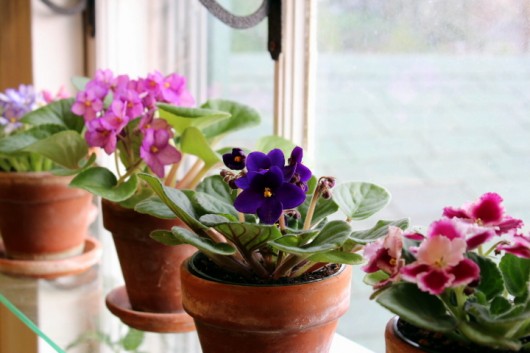 (UPDATED 2020.) I LOVE AFRICAN VIOLETS (Saintpaulia ionantha) and can never have enough of them. They sex up my windows. They provide dazzling decoration for my tabletops and mantels. They even provide gift-plants, because a single leaf will produce multiple babies. To keep the plants in constant bloom, I give them everything they want:
(UPDATED 2020.) I LOVE AFRICAN VIOLETS (Saintpaulia ionantha) and can never have enough of them. They sex up my windows. They provide dazzling decoration for my tabletops and mantels. They even provide gift-plants, because a single leaf will produce multiple babies. To keep the plants in constant bloom, I give them everything they want:
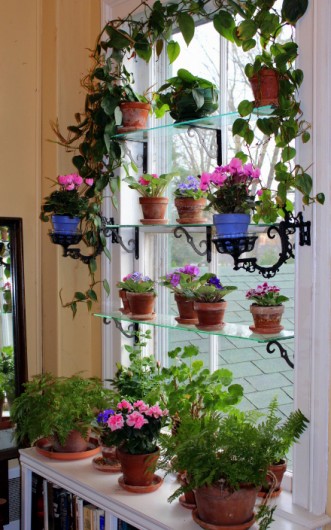 Light. Make no mistake — African violets need plentiful light to bloom. As a rule, give them full sun in winter, and bright light in summer. From October through April, I grow them in the sunny east window of my upstairs bath (above). Then, from May through September, I let the plants dwell in a north exposure or under fluorescents. Otherwise, the harsh summer sun would surely fry their leaves.
Light. Make no mistake — African violets need plentiful light to bloom. As a rule, give them full sun in winter, and bright light in summer. From October through April, I grow them in the sunny east window of my upstairs bath (above). Then, from May through September, I let the plants dwell in a north exposure or under fluorescents. Otherwise, the harsh summer sun would surely fry their leaves.
To keep the plants shapely, give the pots a quarter-turn every other day.
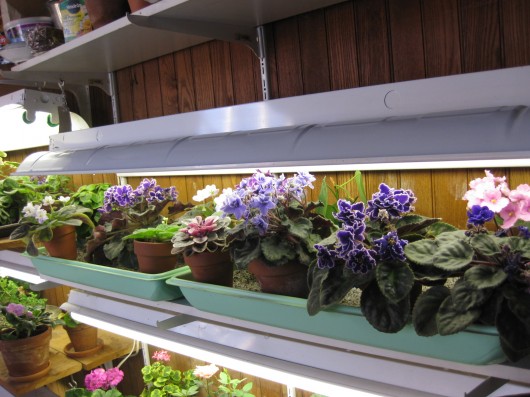 For sensational bloom, place them under fluorescent (or LED) lights. As you can see, I grow dozens of African violets beneath 48-inch fixtures that I attached to shelves in my Writing Room. These are not special "grow-lights", but common, inexpensive "cool white" fluorescents. The plants are set 7-10 inches from the light (5 inches for miniatures and trailers), distances measured from the top of the plants. I leave the lights on for 16 hours each day, followed by 8 hours of darkness. Plants under lights need more food and water, but they always bloom to perfection there.
For sensational bloom, place them under fluorescent (or LED) lights. As you can see, I grow dozens of African violets beneath 48-inch fixtures that I attached to shelves in my Writing Room. These are not special "grow-lights", but common, inexpensive "cool white" fluorescents. The plants are set 7-10 inches from the light (5 inches for miniatures and trailers), distances measured from the top of the plants. I leave the lights on for 16 hours each day, followed by 8 hours of darkness. Plants under lights need more food and water, but they always bloom to perfection there.
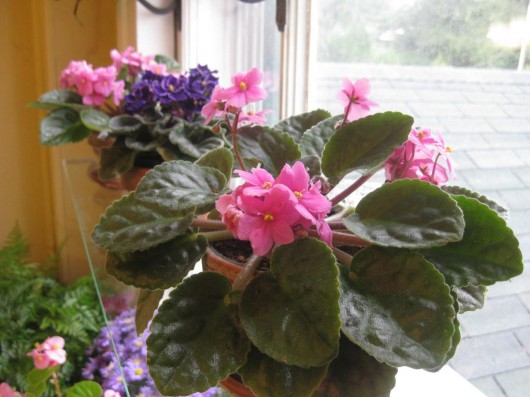 Temperature & Humidity. You may have heard that African violets need indoor temperatures above 70 degrees in order to flower. Actually, this is not true. My own plants bloom and bloom in temperatures that range from 55-65 degrees. On bitter nights, I pull the plants away from windows, and return them only when the morning sun has warmed the glass.
Temperature & Humidity. You may have heard that African violets need indoor temperatures above 70 degrees in order to flower. Actually, this is not true. My own plants bloom and bloom in temperatures that range from 55-65 degrees. On bitter nights, I pull the plants away from windows, and return them only when the morning sun has warmed the glass.
Saintpaulias will not bloom when humidity is low. They revel in about 50% relative humidity, which is fairly high for the average home in winter. Keep in mind that humidity plummets during the heating season. If you suffer from dry skin and a scratchy throat when the furnace is roaring, just imagine how miserable your African violets must be.
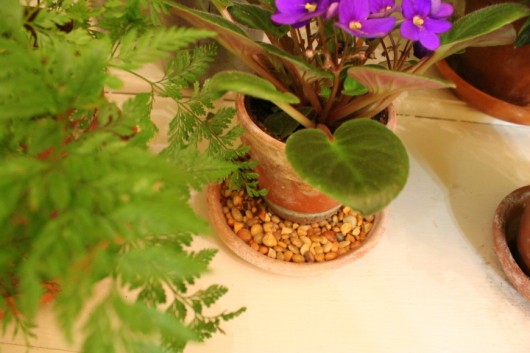 To increase humidity, group plants together. Even better, set them on pebble-filled trays. Galvanized "boot trays" work well, and they can be painted to match your window trim. Keep the trays filled with water, but make sure the plants are resting on the pebbles, above the water-level. When plants are watered from the top, excess moisture drains down into the pebbles, and produces humid air as it evaporates. Pebble-filled bowls or oversize saucers (as above) are suitable alternatives to the trays.
To increase humidity, group plants together. Even better, set them on pebble-filled trays. Galvanized "boot trays" work well, and they can be painted to match your window trim. Keep the trays filled with water, but make sure the plants are resting on the pebbles, above the water-level. When plants are watered from the top, excess moisture drains down into the pebbles, and produces humid air as it evaporates. Pebble-filled bowls or oversize saucers (as above) are suitable alternatives to the trays.
And here's another tip: Grow the plants in clay pots. Clay absorbs moisture, and then releases it as humidity through evaporation.
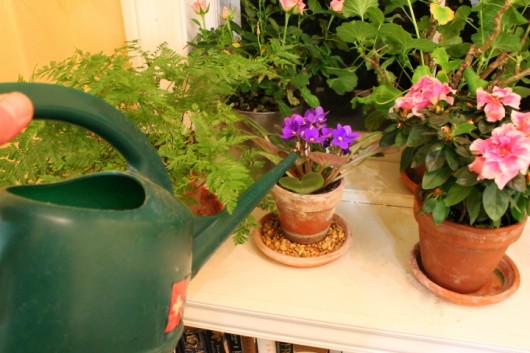 Watering. Use only room-temperature (or slightly warmer) water. You can water from the top or the bottom; sometimes bottom watering is easier because of spreading leaves. To water from below, fill a saucer or bowl with one inch of water, and let the plant absorb all of the moisture it can for exactly 30 minutes. Then pour off any excess. Water often enough to keep the soil moist, but not saturated.
Watering. Use only room-temperature (or slightly warmer) water. You can water from the top or the bottom; sometimes bottom watering is easier because of spreading leaves. To water from below, fill a saucer or bowl with one inch of water, and let the plant absorb all of the moisture it can for exactly 30 minutes. Then pour off any excess. Water often enough to keep the soil moist, but not saturated.
The weekly shower. To remove dust from leaves, and also to deter pests (including aphids and red spider), I shower my plants once a week with room-temperature or slightly warmer water. Afterwards, the plants are kept out of direct sun until their foliage has dried. Leaf spotting only occurs when the temperature of the water is colder than the temperature of the leaves. You can safely return plants to the fluorescent light garden even when leaves are wet.
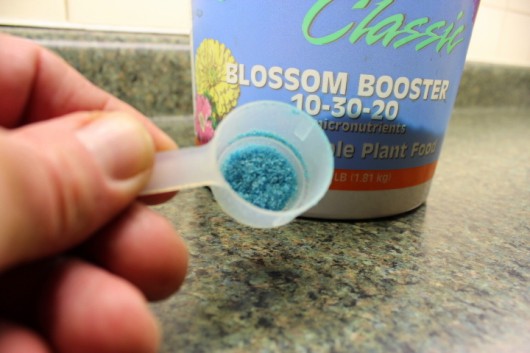 Fertilizing. A low-nitrogen, high-phosphorous, soluble plant food is terrific for African violets. I fertilize every time I water, using Jack's Classic 10-30-20 formula (click here to order from Amazon) . Window garden plants receive one 1/4 teaspoon to 1 gallon of warm water. I increase this to one 1/2 teaspoon food per gallon of water for the hard-working light garden residents.
Fertilizing. A low-nitrogen, high-phosphorous, soluble plant food is terrific for African violets. I fertilize every time I water, using Jack's Classic 10-30-20 formula (click here to order from Amazon) . Window garden plants receive one 1/4 teaspoon to 1 gallon of warm water. I increase this to one 1/2 teaspoon food per gallon of water for the hard-working light garden residents.
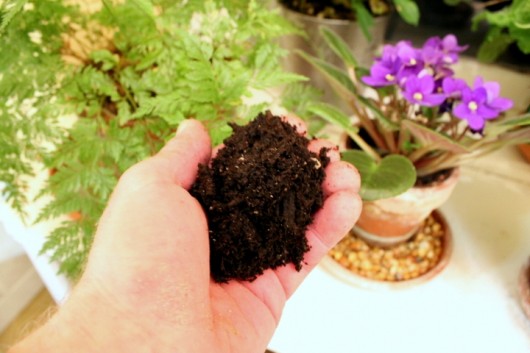 Soil. Use a light, humus-rich, well-draining potting mixture. Almost all commercial mixes intended for houseplants are suitable for African violets.
Soil. Use a light, humus-rich, well-draining potting mixture. Almost all commercial mixes intended for houseplants are suitable for African violets.
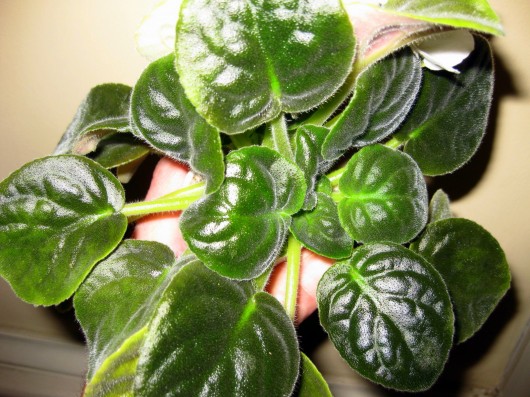 Multiple Crowns & Suckers. With time, most African violets become burdened with multiple crowns and sideshoots, or "suckers." These rob the parent plant of energy, and interfere with bloom. To free your plant of these offenders, follow the directions I described in this post.
Multiple Crowns & Suckers. With time, most African violets become burdened with multiple crowns and sideshoots, or "suckers." These rob the parent plant of energy, and interfere with bloom. To free your plant of these offenders, follow the directions I described in this post.
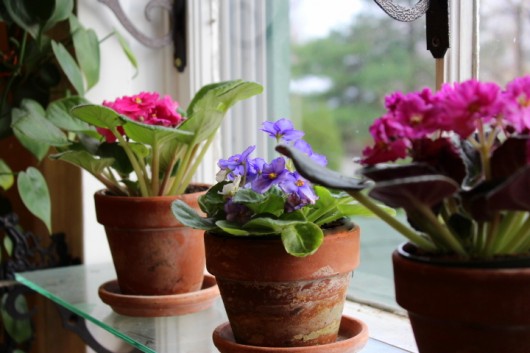 Pots. Mail-order plants always arrive in tiny, 2 1/4-inch plastic pots. You won't need larger pots for months. The African violet in a too-big pot will be slow to bloom. I wait for six months to a year before shifting to 4-inch pots, and that's that. I prefer clay pots — glazed or unglazed, but always with drainage holes — for display in the window garden.
Pots. Mail-order plants always arrive in tiny, 2 1/4-inch plastic pots. You won't need larger pots for months. The African violet in a too-big pot will be slow to bloom. I wait for six months to a year before shifting to 4-inch pots, and that's that. I prefer clay pots — glazed or unglazed, but always with drainage holes — for display in the window garden.
Make New Plants!
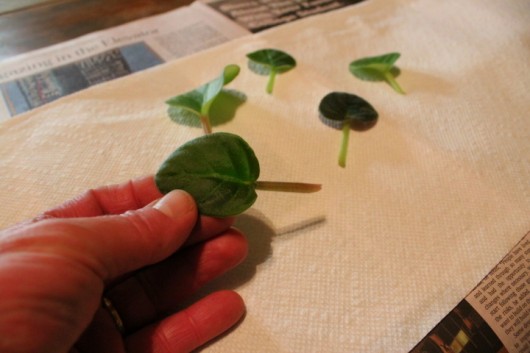 Propagation. It's fun to make new plants from old. Simply snap off a leaf with one inch of stem attached…
Propagation. It's fun to make new plants from old. Simply snap off a leaf with one inch of stem attached…
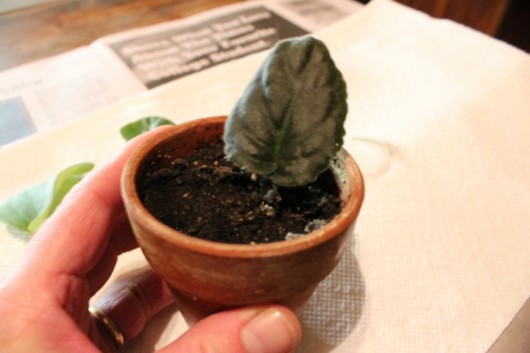 Then insert the stem, or petiole, in a 2- or 3-inch pot of damp soil. Lightly firm the soil.
Then insert the stem, or petiole, in a 2- or 3-inch pot of damp soil. Lightly firm the soil.
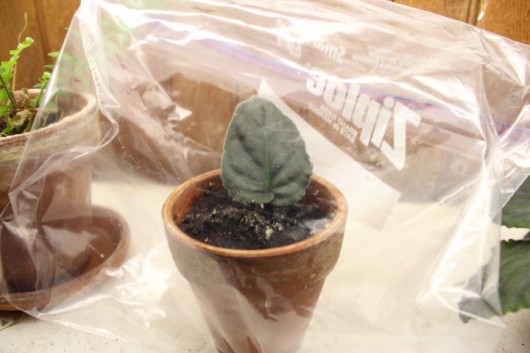 To produce a pleasantly-humid environment for the cutting, place the pot in a clear plastic bag.
To produce a pleasantly-humid environment for the cutting, place the pot in a clear plastic bag.
Then set the pot in a bright but sunless window, or, even better, beneath a fluorescent light.
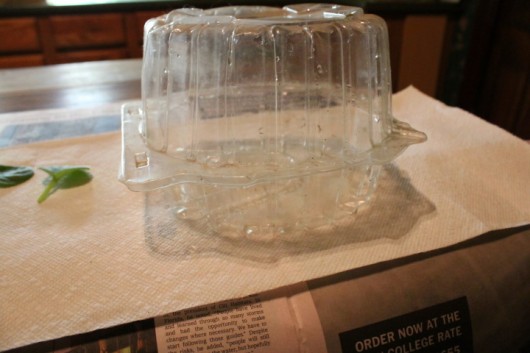 Alternatively, if you want to propagate several leaves, you can make a terrarium out of the plastic tub that (hydroponically-grown) Boston lettuce comes in. Use a knife to cut a few drainage-slits in the bottom of the container…
Alternatively, if you want to propagate several leaves, you can make a terrarium out of the plastic tub that (hydroponically-grown) Boston lettuce comes in. Use a knife to cut a few drainage-slits in the bottom of the container…
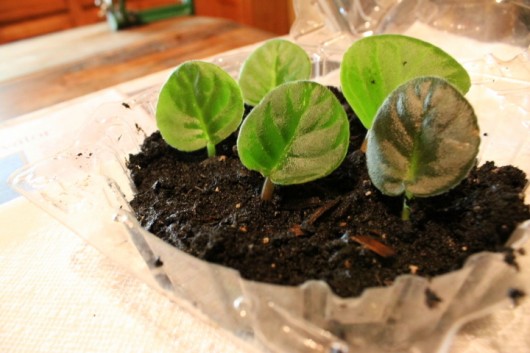 Fill the shallow bottom with soil, and then insert leaves about 2 inches apart from each other.
Fill the shallow bottom with soil, and then insert leaves about 2 inches apart from each other.
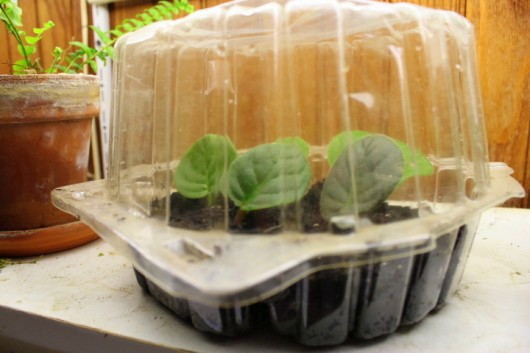 Close the cover, and place the nursery in a bright window or beneath fluorescents.
Close the cover, and place the nursery in a bright window or beneath fluorescents.
Neither the bagged pot nor the Boston-lettuce bin will require water until new plantlets emerge.
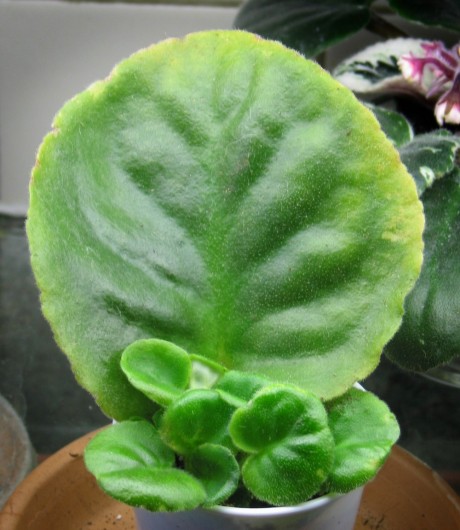 After two to three months have passed, the leaves will give birth to numerous baby plants, as pictured above. One year, I had a single leaf sprout 9 new clones! Separate the tiny rosettes from the mother, and then pot them individually in 2- or 3-inch pots. Give them the same care I described earlier, and in six to nine months they will bloom as beautifully as the parent plant did.
After two to three months have passed, the leaves will give birth to numerous baby plants, as pictured above. One year, I had a single leaf sprout 9 new clones! Separate the tiny rosettes from the mother, and then pot them individually in 2- or 3-inch pots. Give them the same care I described earlier, and in six to nine months they will bloom as beautifully as the parent plant did.
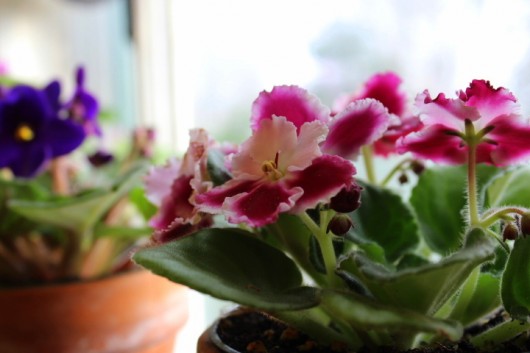 Of course, after propagating the leaves, you'll end up with an entire forest of African violets. But who can complain about that?
Of course, after propagating the leaves, you'll end up with an entire forest of African violets. But who can complain about that?
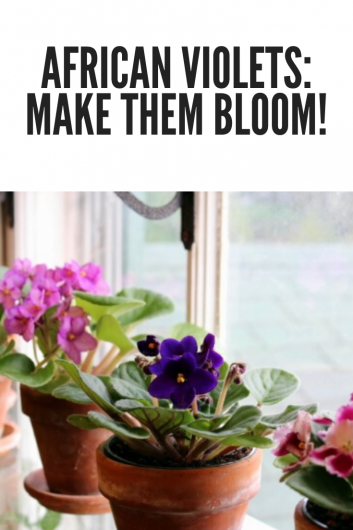 Do African violets bloom well for you? You can let me know by leaving a comment. As always, I love to hear from you.
Do African violets bloom well for you? You can let me know by leaving a comment. As always, I love to hear from you.
Hungry for more? Get my email updates, and subscribe to my YouTube channel.
You may also like:

How To Get African Violets To Bloom
Source: https://www.agardenforthehouse.com/my-african-violet-growing-guide/
Posted by: dreweswhatitat.blogspot.com

0 Response to "How To Get African Violets To Bloom"
Post a Comment